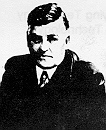

Andrew Greene Carnell was born on 10 April 1877 in St. John's, the son of John T. Carnell and Elizabeth (McCoubrey) Carnell. After receiving his early education at Bishop Feild College and the Methodist College, he apprenticed in 1895 in his father's carriage and undertaking business. In 1902 he graduated from the United States School of Embalmery in Chicago with a first class certificate, and the following year succeeded his father as manager of Carnell's Carriage Factory and Funeral Home. In 1904 he married Mabel Payne and they had two sons and four daughters.
After two unsuccessful forays into colonial politics in 1908 and 1919, Carnell found the municipal arena of St. John's politics more to his liking. In the civic election held on 9 December 1929, he polled the highest vote among the six councillors elected and became Deputy Mayor. Following the death of Mayor Charles Howlett on 31 March 1932, Carnell served as Acting Mayor until the 1933 municipal election, when he won the mayoralty by acclamation. In 1937 he won again by acclamation, while in 1941 and 1945 he easily defeated his opponents.
Carnell's mayoralty between 1933 and 1949 encompassed the years of the Commission of Government in Newfoundland. To the citizens of St. John's, their Municipal Council symbolized the last vestige of democratic government in Newfoundland and their mayor was popularly referred to as the "Mayor of Newfoundland", for his spirited defence of the rights of his citizens against the bureaucratic-minded Commission. To the Commission of Government, however, Council represented a less exalted ideal an "incompetent road and sewerage board" with limited municipal jurisdiction as compared to that found in Canadian and English cities. In its view, the people of St. John's would rather treasure the "illusion of responsible government" than the "improvement in the city's condition which [Council's] removal would produce." In 1934 the Commission offered Council a $500,000 loan for city improvements, but council rejected it because Mayor Carnell was unwilling to give the Commission complete jurisdiction over civic expenditures until the loan had been repaid. Two years later the Commission considered the idea of abolishing the Council and appointing in its place a city manager, but finally rejected the move because of its political unpopularity.
It was Carnell who, as mayor in 1944 succeeded, after a decade of protracted negotiations, in having the Commission waive the $1,000,000 debt which the city owed the government. In the same year he helped organize the St. John's Housing Corporation, while in 1948 he was instrumental in establishing a citizens' committee to raise funds for the construction of Memorial Stadium which was opened in 1955. Mayor Carnell, who has been referred to as "The La Guardia of St. John's," maintained a vigorous program of sewer, water, and street improvements, while simultaneously providing taxpayers with "Solvent, Sane and Square Civic Government." Carnell lost the 1949 election to his Deputy Mayor, Harry G. R. Mews. He died at St. John's on 26 January 1951.